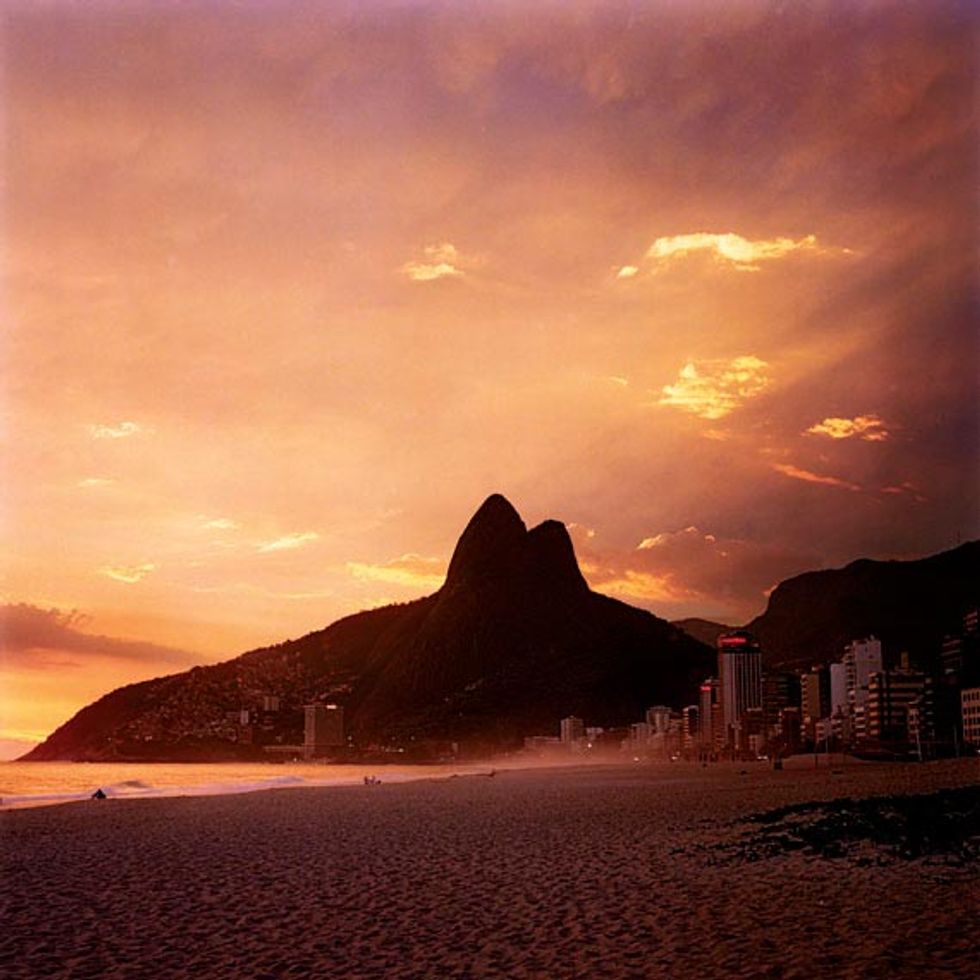From the rooftop of Rio’s Fasano hotel, the setting sun illuminated Sugarloaf Mountain to cinematic effect while perfectly tanned couples in tiny bathing suits soaked up the last waning rays from sunbeds around the infinity pool. My husband and I sipped caipirinhas, while South American starlets, models, and media types congregated at the bar, many in barely-there dresses accessorized with sleek, blown-out hair. A pick-up soccer game had begun on the beach below, sending up the shouts of ripped guys calling fouls to mingle with the soundtrack of piped-in samba. Sexy glamour meets the beach—welcome to reinvigorated Rio de Janeiro.
Before traveling back to Rio this past year with my husband and 2-year-old, it had been 20 years since my last visit. This time around, I found a completely different city. My most vivid memory of that first trip was a sense of looking at Rio’s natural assets from inside a protective bubble: We went to cocktail parties and polo games in locked cars with a driver, ate our meals inside walled estates, and stayed mostly by the pool at Copacabana Palace rather than on the famous golden beach. Back then, it wasn’t recommended to walk on certain stretches of sand, and the tin-roofed shanty houses of the hillside favelas were a chilling reminder of the city’s deep rift between rich and poor.
But these days, Rio bursts with new energy, thanks in large part to the international nod of approval that came with the acquisition of the 2014 World Cup and the 2016 Summer Olympics, as well as the expected wave of construction that follows such high-profile events. Backed by ocean on one side and primordial mountains on the other, a 300-acre Olympic Park will be erected by global firm AECOM, who also designed the standout park in London. Rio’s two airports will undergo substantial upgrades, and there are plans for an $18 billion high-speed rail that will link Rio with São Paolo in time for the World Cup.
Along with these improvements, there is a feeling of promise and possibility lifting Rio up, where the combination of increased economic diversity and a rising middle class means a more positive outlook for the future. Mix that all up with the devil-may-care attitude, disarming beach culture, and nightlife that make Rio so sexy, and it’s enough to send the place into overdrive.
This time around, we found a sense of freedom everywhere. At the beach playground in Leblon where we took our son, young mothers—kitted out in caftans from the city’s rising fashion stars (including Andrea Marques and Patachou)—felt safe enough to leave their bugaboos parked on the sidewalk. I could run alone on the promenade alongside the ocean, where model types Rollerbladed in thongs, gay couples did pull-ups at an outdoor gym, and Gisele lookalikes played volleyball in front of the crashing waves. At night when the samba schools practiced their moves, we watched locals joined at the hips grabbing handsome strangers for a quick dance. We savored everything from freshly caught fish wrapped in banana leaves to five-course meals at restaurants, like CT Boucherie, helmed by celebrity chefs. We drank cocktails at restaurants with millions of dollars worth of vintage wine in custom cellars (Olympe and Duo), and sipped half-beers (chopps) at Jobi with the city’s older generation. In the early morning, we shared whole coconuts for $1 with club kids just coming back from a night of dancing and drank coffee with neighborhood matrons looking like they were still dressed in their nightgowns.
Tuna Carpaccio from Fasano al Mare. Courtesy of Fasano al Mare
Yes, the sprawling favelas still exist and certain neighborhoods are best to stay away from. But nowadays, the government is actively trying to shut down the crime scene and clean up the favelas one by one in time for the 2014 games. The drug lords have been pushed out of places like Vidigal, an area that came to represent the worst of gun violence and gangs. Since 2012, investors have snapped up real estate there—Vidigal’s hillside has a bird’s-eye view of the city and its beaches. A luxury hotel here would have been unthinkable a few years back, but there is one (yet unnamed) under construction now by architects Helio Pellegrino, Conrado Denton, and Antonio Rodrigues (of Rio’s Bar Belmonte).
A handful of cultural institutions is also adding nuance to the city that was once known as a hedonistic pleasure palace. And jackpot waterfront locations, star architecture, and new venues such as the $250 million Cidade das Artes concert hall are likely to lure locals as well as tourists. Designed by French architect Christian de Portzamparc, the music hall is a sculptural, industrial building (reminiscent of the Sydney Opera House) that opened as the home for the Brazilian Symphony Orchestra in Rio’s Barra da Tijuca neighborhood in March.
Later this year, the Museum of Image and Sound will upgrade to futuristic digs designed by New York firm Diller Scofidio + Renfro. With glass-fronted views of Copacabana and an open-air, 300-seat rooftop theater for screenings, the building is set to be one of the city’s design-centric showcases.
Even sustainability is on the docket here: The Museum of Tomorrow (focusing on science, technology, and the future), now underway by Spanish architect Santiago Calatrava, will bring pools of recycled rainwater, five-plus acres of gardens, and a photovoltaic roof to Rio’s remastered waterfront—called the Marvelous Port—hopefully in time for the 2016 Olympics. Knowing how the natives enjoy their downtime, it’s not hard to imagine that these venues will also become home to some of the most extravagant parties in South America.
In many ways, Rio is Brazil’s Miami. Both cities struggled in the 1990s but have reinvented themselves as magnets for hotels, nightlife, and burgeoning culinary scenes. Each has a titillating combination of scantily clad denizens and a new sense of sophistication. Like South Beach in its heyday, Leblon (the beach area just southwest of Ipanema) has emerged as an epicenter for shops and restaurants, many of them tucked into the alleys behind swank residential buildings with million-dollar ocean views.
This current buzz is most of all a boon to the locals, who make this city so exciting. Everywhere you look there are signs of Rio’s rebirth—sports stadiums, sparkling skyscrapers, and cutting-edge cultural landmarks. And with the addition of these new attractions, the city’s natural assets—that epic beach and sparkling ocean—have never looked better.
This article was published in 7x7's May issue. Click here to subscribe.
































